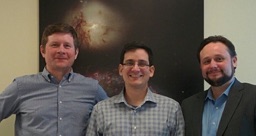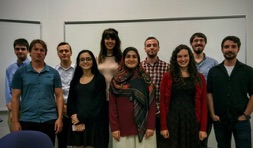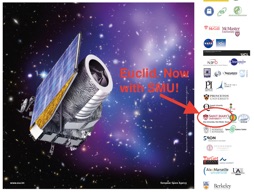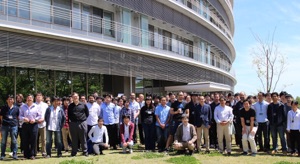
2017 January 18: Euclid - now with SMU!


Today Bobby has successfully defended his PhD thesis “Using Model Spectral Energy Distributions to Study Galaxy Masses: Now and in the Future”. Only minor corrections to do as well. Well done, Dr. Bobby!
In the photo: Dr. Sorba with his thesis advisor (left) and external examiner Dr. Adam Muzzin (right). Also on the thesis defence committee - but not present in the picture as he was behind the camera - was SMU’s Dr. Rob Thacker.

2017 May 15: Mahassen joins the group for the summer
Undergrad astrophysics student Mahassen-Hawraa Al-Saegh joins our research group for the summer on an NSERC USRA award. Mahassen is going to study how a Kardashev Type-III civilization (namely a super-advanced civilization that has already colonized its entire galaxy) would go about colonizing the Universe around it - a realistic Universe that is not only expanding but also filled with large-scale structure.
Welcome to the team, Mahassen!

2017 August 9: Gurpreet defends her MSc thesis
Gurpreet’s research concerns UMPGs - Ultra Massive Passive Galaxies that by redshift ~1.6 have already ceased star formation but not before converting close to a trillion (1011.5) solar masses of gas into stars. Gurpreet has found that these “dead monsters” are associated with extremely massive and rare dark matter halos that contain about a hundred trillion (1014) solar masses of dark matter! The implication is that these galaxies mark the locations of galaxy protoclusters that by today will turn into massive galaxy clusters like Coma and Virgo. A similar result holds for groups of (somewhat) lower-mass quiescent galaxies. This then leads to a picture that UMPGs and quiescent galaxy groups at z~1.6 are two (possibly related) channels for building present-day central galaxies in massive clusters, such as M87 in Virgo.

2017 June 2: CASCA 2017


2017 May 17-19: CLAUDS team in Sendai
We attend many interesting science sessions and I give an update on the status of the CLAUDS project. It’s also good to be in Sendai again - it’s been 4 years since I was there for my sabbatical. Beautiful city in a beautiful part of Japan. Alas, the conference is so busy that I don’t have time to visit my friends at Suzaku.

2017 August 29: Lingjian joins the team.
Lingjian Chen, recently graduated from the Shangai Jiao Tong University, just arrived to start his MSc in our group. Welcome to the team, Lingjian!

2017 September 2: Mahassen wraps us summer term.

2017 October 12: GIRMOS funded

GIRMOS is an instrument for Gemini that will use adaptive optics and multiple intergral-field spectroscopy units to study the detailed working of galaxies in the distant universe.
SMU’s part in the project is to develop the data simulator and data reduction pipeline... and, of course, we also plan to use it for observing distant galaxies once GIRMOS is on the telescope in 2023 or so.


Jean Coupon, a friend and collaborator on the CLAUDS project, visits us from Geneva Observatory for the week of Nov 20-25. In addition to giving a fascinating colloquium on Probing the Galaxy-Mass Connection in TeraByte-scale Imaging Surveys (link here), Jean spends his time in Halifax discussing ongoing science and thinking up new projects with our group members. A great visit, all-around!
[photo of Jean by Henry McCracken]



For the first time in a while I actually go to the telescope to get data (most data are now taken in remote or service-mode observing!). Spending 4 nights at Gemini-North on the Big Island, taking spectroscopy of very distant luminous galaxy candidates with Yoshiaki Ono. We had bad luck with the weather and instrument problems and only managed to observe a couple of sources, but Gemini took much more data for us in queue mode later in the semester (yay!), so we have some nice spectra after all.





